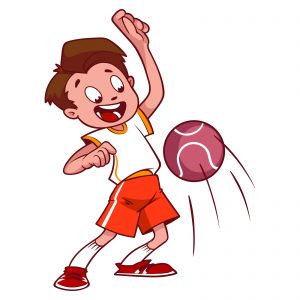Childhood is defined as the age span from birth to adolescence. The WHO subdivides childhood into two: an infant, who is a child younger than one year, and an adolescent being a child aged 10 to 19 years. Interestingly there has been a global noted increased level of physical inactivity among this age span that would previously have been considered active. This is likely as a result of advancement in technology and modernization in the perceived lifestyles.
The desire of activity is designed by nature to promote our physical well-being. Physical activity is the law of physical health.
Edward Brooks, 1882

Children with a chronic disease or disability are less active than their healthy peers. There are many reasons for such suboptimal physical activity (biological, psychological and social factors). Furthermore, the lack of specific guidelines for ‘safe’ physical activity participation poses a barrier to increasing activity. But physical activity provides significant general health benefits and improves disease outcomes according to Philpatt, Houghton, & Luke.
WHO director Dr. Margret Chan once said that “Healthcare and Lifestyle are important determinants of health, but it is factors in the social environment that determine access to health services and influence lifestyle choices in the first place.” Children participation in physical activity thus is greatly influenced by the social environment they live in and parenting skills they get acquitted with.
A child is not a smaller version of an adult but a whole person with entirely different needs and demands that should concur appropriately with recommended physical activity levels as illustrated below by the American academy of Pediatrics;
UNDER–FIVES:
180 minutes (three hours) spread throughout the day, once a child is able to walk. For children who are not yet walking physical activity should be encouraged from birth, particularly through floor-based play and water-based activities in safe environments.
CHILDREN AND YOUNG PEOPLE (5–18 YEAR OLDS):
At least 60 minutes and up to several hours every day which should be a mix of moderate intensity aerobic activity, (for example walking to school or riding a bike) and vigorous intensity aerobic activity, (for example running, gymnastics and football). Vigorous intensity activities strengthen muscle and bone and should be included at least three days a week.
All children and adults are advised to minimize the time spent being sedentary for extended periods. And take part in activity levels equal to age.
| CATEGORY | AGED UNDER 5 | AGED 5-13 |
| Meets recommendations | At least 180 minutes (3h) of Physical Activity on all 7 days in the last week. | At least 60 (1h) of moderate to vigorous physical activity(MVPA) on all seven days in the last week |
| Some activity | From 60-170 minutes of Physical Activity on all 7 days in the last week | From 30-59 minutes of MVPA on all seven days in the last week. |
| Low activity | Fewer than 60 minutes of activity on each day ,or activity of 60 minutes or more on fewer than 7days in the last week. | Fewer than 30 minutes of MVPA on each day or MVPA of 60 minutes or more on fewer than seven days in the last week. |
Creating an environment that suites development of children to embracing an active lifestyle is a one healthy initiative to promoting future healthcare seeking behaviors which would include:
- Caregivers and parents should be aware of the role played by physical activity in facilitating child’s movement skills and development.
- Infants’ should interact with parents and caregivers in daily physical activity that is geared to promoting the exploration of the environment.
- Infants’ physical activity should promote development of movement skills that would be building blocks for complex movement tasks as toddlers.
- Infants’ and toddlers should have environment that meets or exceeds recommended safety standards for performing large muscle activities.
- Sporting activities should be introduced to build passion and skills for specialized physical activity.
Sibley & Etnier suggest that there is overwhelming evidence for positive relationship between physical activity and cognitive functioning in children. Schools spent much time building the cognition domain but less on Physical activity domain yet the mind and body are a single entity that should be established together. Physiologically exercise has a role in growth which is the increase in size, development which is specialization of cells along a line of functioning and Maturation which is the accomplishment of the fully functioning as an adult form.
A child who plays is the child who grows healthy every step of life
Professional physical activity for children is an area that needs much attention since measuring health related fitness in children is difficult since most hypokinetic diseases are not manifested till adulthood. Fundamental ingredients to children physical activity will entail;
- Movement skills development
- Exercise rehabilitation
- Fitness testing
- Exercise socialization
- Exercise Education
Some of the benefits which are accrued by a child who plays range across anatomical, physiological and psychological inputs such as increased bone density, decreased lipid profile, improved posture, reduced injury occurrences, healthy body composition, improved self-conceptualization, outstanding mental discipline, acquisition of skills faster and improved lifestyle attitude. A healthy nation is established by citizens who are physically active with the energy to initiate development hence naturing this gift from childhood is the best initiative a society can uphold.